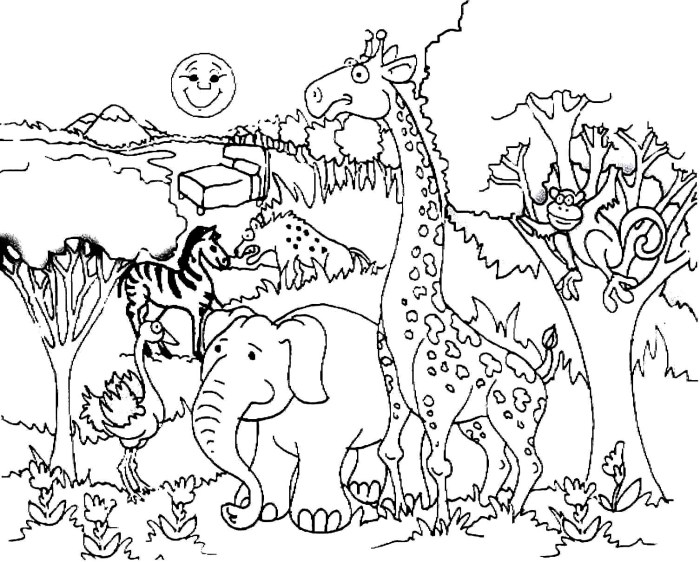Target Audience Analysis: Free Forest Animals Coloring Pages Preschool

Free forest animals coloring pages preschool – Preschool children, typically aged three to five, possess unique cognitive and artistic capabilities that significantly influence their engagement with coloring activities. Understanding these abilities is crucial for designing effective and enjoyable coloring pages.Preschoolers are in a crucial stage of development, actively exploring their world through sensory experiences and imaginative play. Their cognitive abilities are rapidly expanding, allowing them to grasp basic concepts, recognize shapes and colors, and begin to understand simple narratives.
Their artistic skills, while still developing, are characterized by a vibrant expression of creativity, often prioritizing bold colors and imaginative compositions over realistic detail.
Developmental Benefits of Coloring for Preschoolers
Coloring activities offer numerous developmental benefits for preschoolers. The act of carefully holding and maneuvering a crayon or colored pencil strengthens fine motor skills, improving hand-eye coordination, dexterity, and pencil grip. This enhanced control is essential for future writing and drawing skills. Furthermore, coloring fosters creativity and self-expression. Children can freely explore their imagination, choosing colors, patterns, and designs that reflect their individual preferences and interpretations.
The process of coloring allows them to translate their inner thoughts and feelings into visual representations, promoting emotional development and self-discovery. The completion of a coloring page also provides a sense of accomplishment and boosts self-esteem.
Preferred Visual Styles and Animal Representations
Preschoolers generally respond best to visual styles that are bright, simple, and engaging. They are often more drawn to cartoonish or simplified representations of animals than highly realistic ones. The level of detail should be appropriate for their age and skill level, avoiding overly intricate designs that might frustrate them. Animals that are familiar and appealing, such as playful bears, friendly foxes, or adorable bunnies, are usually preferred.
Bright, primary colors are also more captivating than muted or complex color palettes.
| Illustration Style | Description | Pros | Cons |
|---|---|---|---|
| Realistic | Detailed, anatomically accurate depictions of animals. | Can be educational, showing animals in their true forms. | May be too complex for preschoolers to color effectively, potentially leading to frustration. |
| Cartoonish | Exaggerated features, simplified shapes, and bright colors. | Appealing and easy for preschoolers to color, encouraging creativity. | May not accurately represent the animal’s true appearance. |
| Simplified | Basic shapes and Artikels, minimal detail. | Ideal for very young children, focusing on color and large motor skills. | May lack visual interest for some children. |
| Stylized | Unique artistic interpretation, often with bold lines and flat colors. | Can be visually striking and encourage creative expression. | Might be less recognizable as specific animals to some children. |
Content Creation

Creating engaging and age-appropriate coloring pages for preschoolers requires careful consideration of the animals depicted. The chosen animals should be both visually appealing and easily recognizable to young children, fostering a positive coloring experience and encouraging creativity. Simplicity of form is key to ensuring the coloring activity remains manageable and enjoyable for this age group.Animal selection plays a crucial role in the overall success of the coloring pages.
The animals must be visually simple enough for preschoolers to color without frustration, yet interesting enough to hold their attention. Familiarity is also essential, as children are more likely to engage with animals they already know and recognize from books, television, or real-life encounters.
Animal Selection Criteria and List, Free forest animals coloring pages preschool
The following ten common forest animals meet the criteria of simplicity of form and familiarity for preschoolers: deer, rabbit, squirrel, fox, owl, bear, raccoon, hedgehog, butterfly, and ladybug. These animals are easily recognizable by their distinct shapes and features, making them ideal for coloring pages aimed at this age group. They also offer a variety of shapes and sizes, providing diverse coloring opportunities.
The inclusion of insects (butterfly and ladybug) adds variety and introduces children to a broader range of forest life.
Coloring Page Layouts
The following Artikels three different coloring page layouts, each showcasing a unique grouping of the selected animals to cater to different preferences and learning objectives.
- Layout 1: Mammalian Forest Friends This layout features only mammals: a deer, a rabbit, a squirrel, a fox, a bear, and a raccoon. The animals are arranged in a playful, slightly overlapping manner, creating a sense of interaction and movement. The deer, being the largest, is positioned centrally, with the smaller animals grouped around it. This layout allows children to focus on coloring a variety of mammals with varying levels of detail.
- Layout 2: Birds and Mammals This layout combines mammals and birds: a deer, a rabbit, a squirrel, and an owl. The owl is perched on a branch above the mammals, creating a sense of hierarchy and adding a vertical dimension to the design. The mammals are arranged similarly to Layout 1, but with space allocated for the owl. This layout introduces the concept of different animal classes within the forest ecosystem.
- Layout 3: Diverse Forest Life This layout showcases a diverse range of animals: a deer, a butterfly, a ladybug, a hedgehog, and a squirrel. The animals are scattered across the page, creating a more dynamic and less structured composition. The butterfly and ladybug are smaller and more detailed, providing a challenge for children who are ready for more intricate coloring. The deer and hedgehog provide larger, simpler areas for coloring.
This layout emphasizes the biodiversity of the forest environment.
Yo, preschoolers! Digging those free forest animals coloring pages? Level up your animal coloring game by checking out the awesome habitats in these coloring pictures, like coloring pictures of animal habitats , to see where your favorite forest creatures actually chill. Then, get back to those adorable forest animal coloring pages – you’ll totally nail it now!
